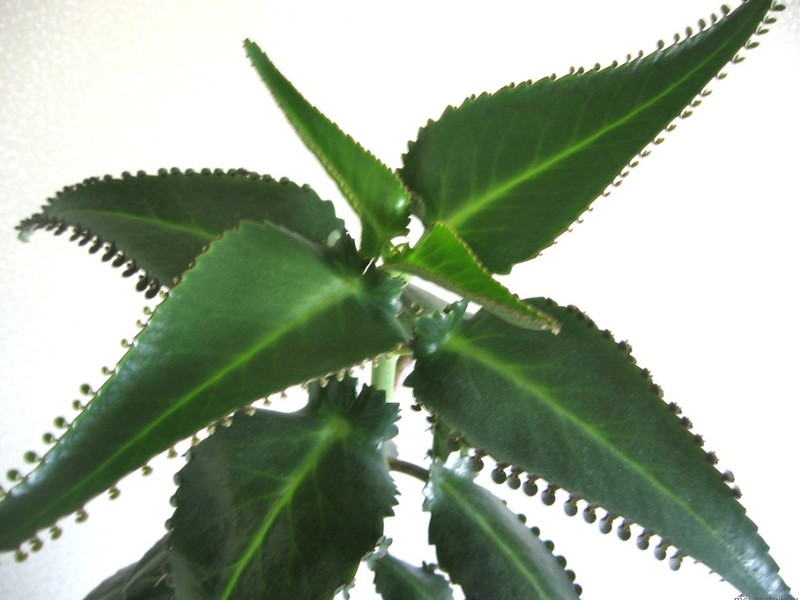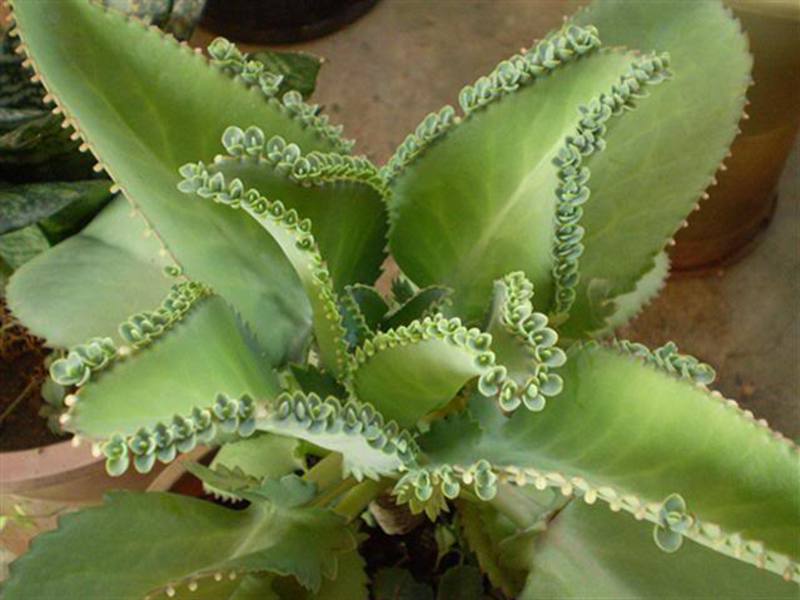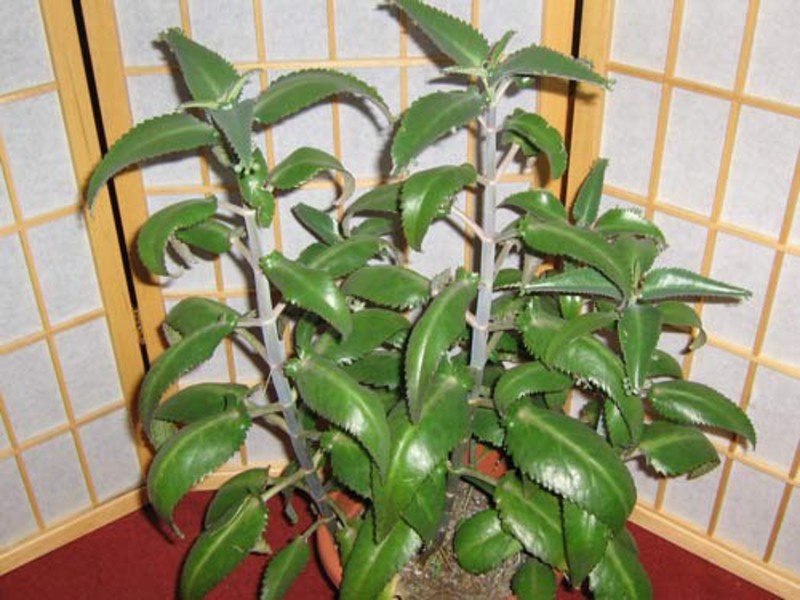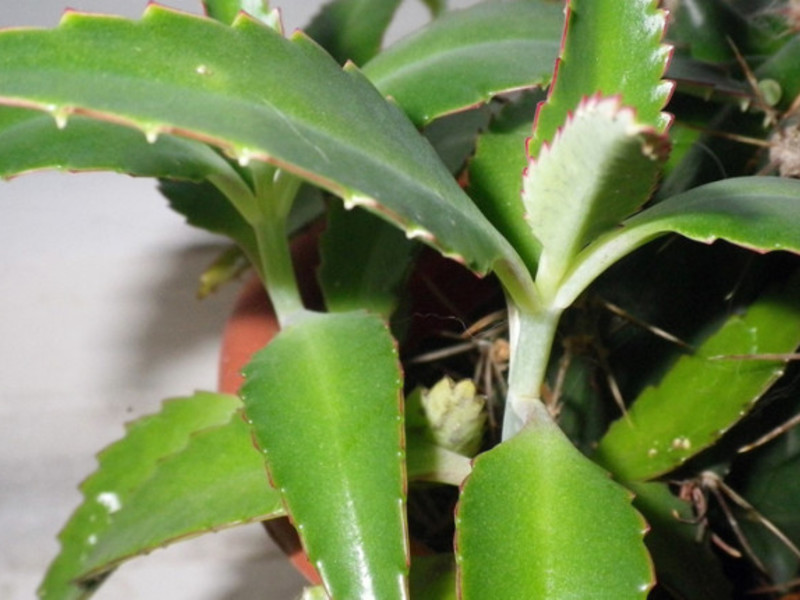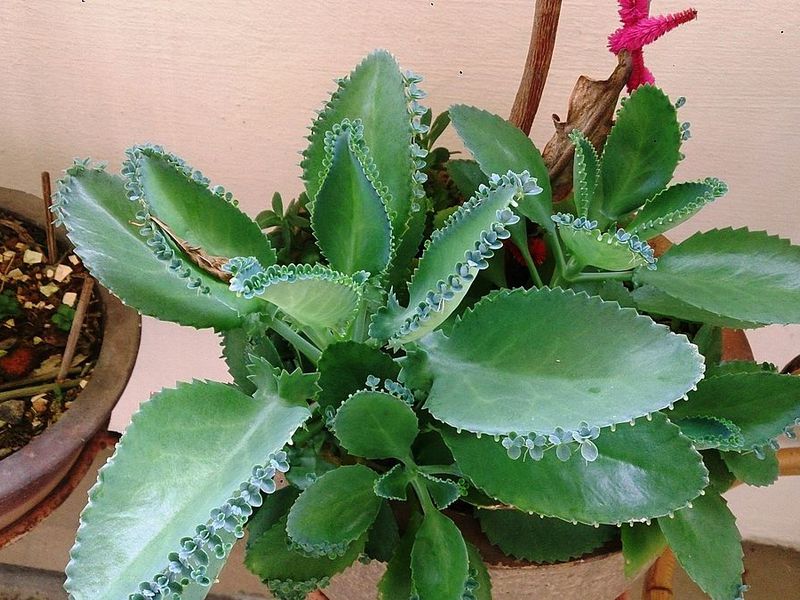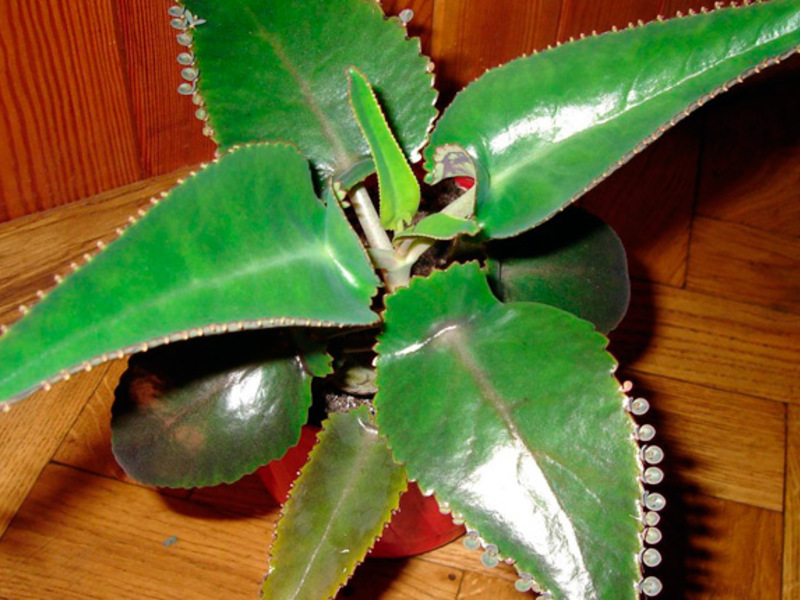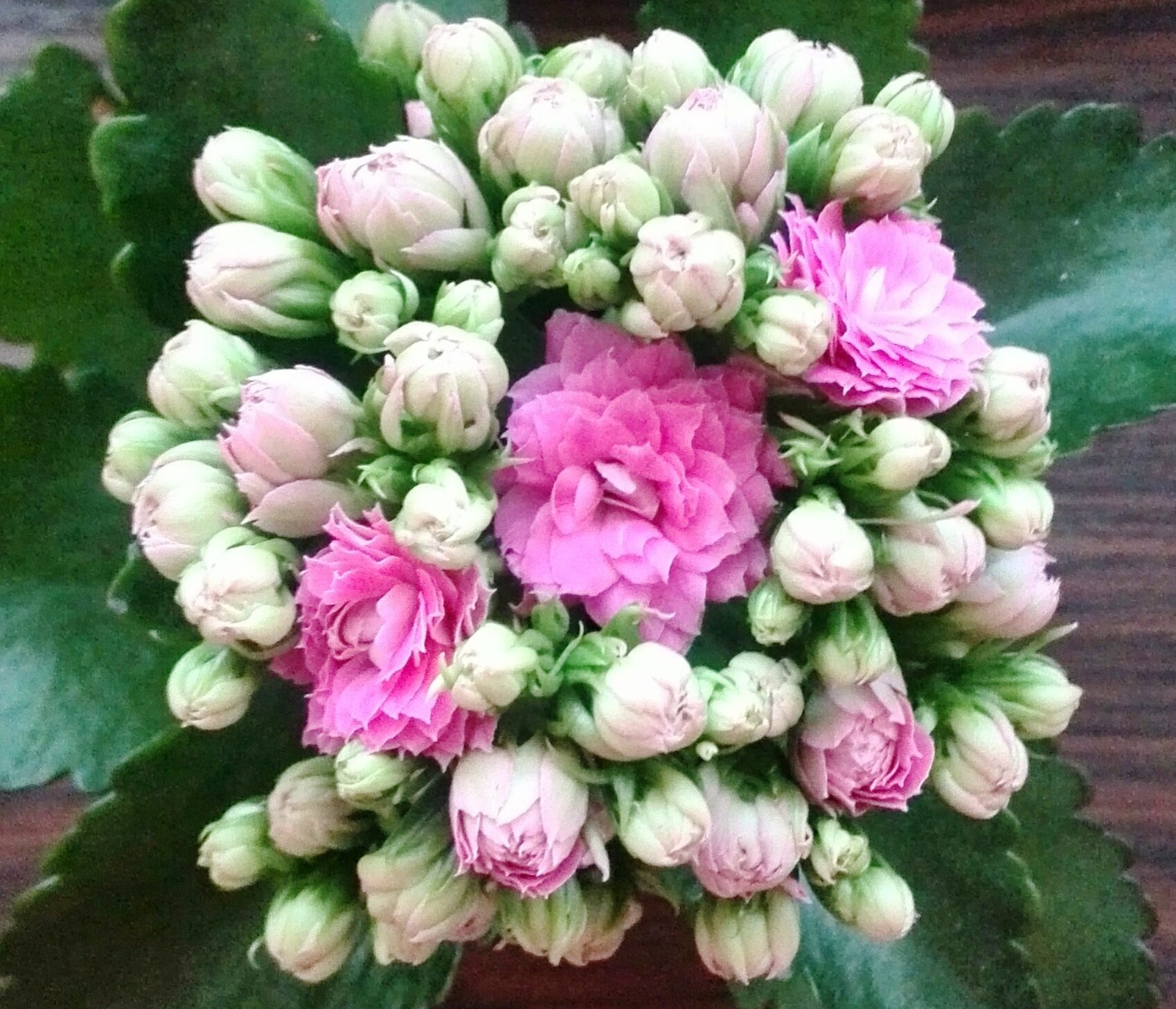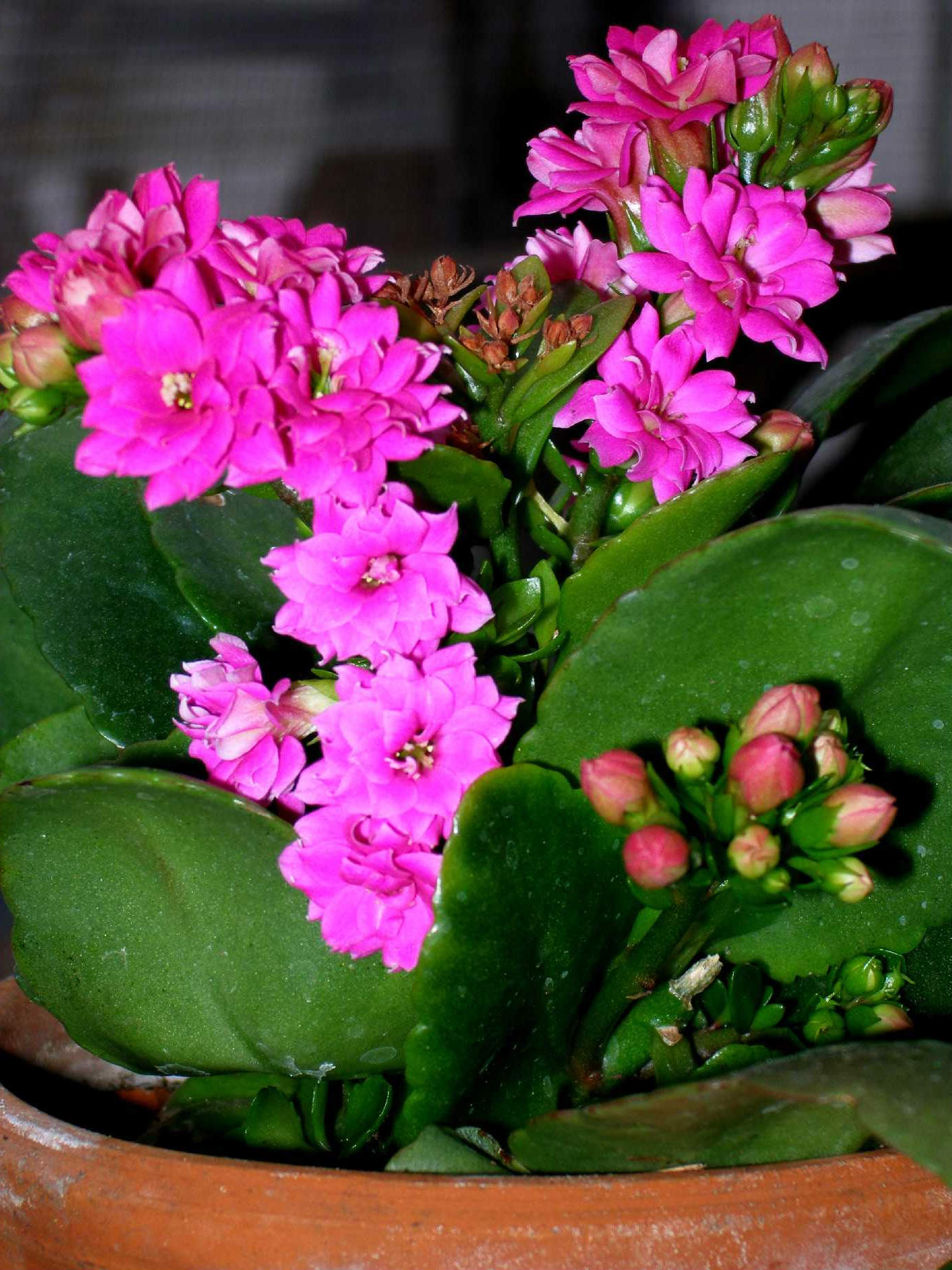Kalanchoe is a succulent plant that, due to its decorative appeal and the medicinal properties of its fleshy leaves, is very popular among home growers. In nature, Kalanchoe grows in Australia, Africa, Southeast Asia. The plant grows well at home. The main thing in this case is to adhere to the rules of caring for this curative succulent.
Content
Description, varieties and photos of Kalanchoe
The plant is distinguished by thick and juicy stems and leaves. Leaves of various shapes are arranged oppositely. They can be pinnately cut, lobed, toothed, whole-edged or simple.
Quite large drooping, erect or four-membered flowers can be red, reddish, yellow, greenish, purple, pink or white.
Kalanchoe has more than two hundred species. But at home they grow and are very popular a little more than ten varieties... Most of them bloom beautifully. However, some species bloom very rarely or have no flowers at all.
- Lobular or dissected Kalanchoe is popularly called "Reindeer Horns"... This herbaceous plant is distinguished at first by erect shoots, which eventually lodge. Due to this, the lobular Kalanchoe can be grown as an ampelous plant. The light green, fleshy leaves of the succulent have a waxy bloom. They are deeply dissected along the edges. It blooms profusely with tubular yellow flowers.
- Kalanchoe tube-flowered is a semi-shrub growing up to 70 cm. Its grayish-green, long and narrow numerous leaves 0.6 cm wide and up to 13 cm long, in the upper part are strewn with many baby buds. The plant tolerates indoor conditions, where it blooms profusely with red flowers. The corolla tube reaches 2.5 cm in length.
- Kalanchoe fiery is a grassy, low-branched succulent, the height of which can reach from 30 to 40 cm. Serrated obovate leaves 3 cm wide and 6-8 cm long, taper at the base. The petals are bright orange or bright red petals up to 2 cm in diameter. The plant requires a moderately cool room for good growth.
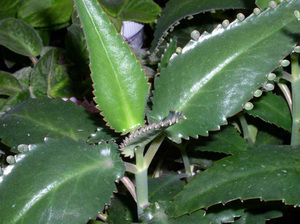 Panicled-flowered Kalanchoe grows up to 60 cm. It is a densely leafy plant with silvery-white, obovate leaves 7 cm wide and up to 15 cm long. The upper leaves are smaller than the lower ones, and are less common. The inflorescence is a panicle on which there are yellow flowers with rounded, small petals. The highly decorative succulent blooms profusely in April and May. Propagated by bulbous buds that form after flowering.
Panicled-flowered Kalanchoe grows up to 60 cm. It is a densely leafy plant with silvery-white, obovate leaves 7 cm wide and up to 15 cm long. The upper leaves are smaller than the lower ones, and are less common. The inflorescence is a panicle on which there are yellow flowers with rounded, small petals. The highly decorative succulent blooms profusely in April and May. Propagated by bulbous buds that form after flowering.- Bryophyllum Mangina is an ampelous plant with fleshy leaves blooming with drooping pink, bell-shaped flowers.
- Large-flowered Kalanchoe grows up to 60 cm. Its light green leaves are located on short petioles. From exposure to direct sunlight, they begin to blush. Blooming with light yellow fragrant flowers, the succulent is distinguished by an umbrella-shaped inflorescence and ovoid petals.Flowering occurs in the month of May. Grows well in moderately cool rooms.
- Kalanchoe marble is an ornamental shrub with a height of 50 cm. The leaves of the succulent are notched-toothed at the edges, tapering at the base. On both sides, first green, and then grayish, they are covered with large lilac or brown spots. From January to April, the plant blooms with white flowers with ovate-lanceolate petals. The tubular corolla of the Kalanchoe reaches 7-8 cm in length.
- Kalanchoe felt or "cat ears" refers to shrubs. The succulent got its name due to the fact that its erect shoots are densely covered with hairs. The sessile, oblong-ovoid leaves are similar to the ears of a cat. They grow in length up to 5-6 cm. The plant is distinguished by a small umbellate inflorescence, petals and a tubular corolla, the length of which is about 12 mm.
- Kalanchoe Brossfeld - it is an erect, branched shrub, the height of which can reach up to 30 cm. Its bare, wide, green leaves are ovoid and grow up to 7 cm long. The flowering succulent is strewn with erect red flowers located on an umbrella-shaped inflorescence. They reach 1 cm in diameter and have narrow, melliferous scales. Brossfeld blooms all spring. After that, caring for him consists in pruning the peduncles, rarely watering and storing the plant in a dark place. After a month, the Kalanchoe can be put back in a lighted place and watered as usual.
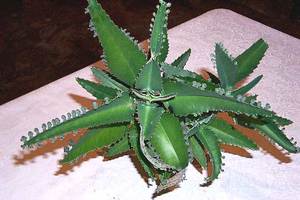 Kalanchoe Bekharskoe is a well-developed, powerful shrub with tomentose-pubescent shoots at the top and a bare trunk at the bottom. The flowering plant is distinguished by small, drooping flowers, linear petals and a pitcher-shaped corolla tube.
Kalanchoe Bekharskoe is a well-developed, powerful shrub with tomentose-pubescent shoots at the top and a bare trunk at the bottom. The flowering plant is distinguished by small, drooping flowers, linear petals and a pitcher-shaped corolla tube.- Kalanchoe Benta Is a low-branched, powerful shrub up to one meter high. Large, rounded leaves up to 40 cm long are arranged in six pairs. The umbrella-shaped inflorescence is covered with white flowers with ovoid petals. Succulent blooms in April-May.
- Kalanchoe pinnate, a photo of which can be viewed in our gallery, grows up to one meter and belongs to perennial herbaceous plants. The young upper leaves of the succulent are feathery and light green. Over time, they become red and serrated, jagged around the edges. On the leaves, in the depressions of the teeth, buds are first formed, from which young tiny processes with roots develop over time. They can be separated, rooted in the soil, and with proper care, a new plant can be grown.
- Bryophyllum Degremona grows up to 50 cm in height. On its stem are fleshy bare leaves, serrate along the edge and slightly curling along the midrib. They are gray-green on the upper side, and light green with purple spots on the bottom. Pink flowers with petals up to 5 mm strewn with paniculate inflorescence. Bryophyllum Degremona blooms usually in winter. After that, buds are formed along the edge of the leaves between the cloves, from which new plants develop.
Kalanchoe medicinal - photo
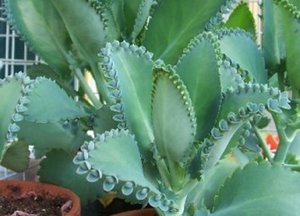 Feathery Kalanchoe and Dergemona bryophyllum have healing properties. The plumose succulent does not have a spectacular appearance, but it is famous for its medicinal properties. The sap of the plant has long been used by the inhabitants of Madagascar for the treatment of various diseases.
Feathery Kalanchoe and Dergemona bryophyllum have healing properties. The plumose succulent does not have a spectacular appearance, but it is famous for its medicinal properties. The sap of the plant has long been used by the inhabitants of Madagascar for the treatment of various diseases.
Isolated from fresh leaves juice has anti-inflammatory effect... It can be used to treat stomatitis, periodontal disease, tonsillitis, migraines, flu and some infectious diseases. The healing properties of Kalanchoe juice help well to heal wounds, frostbite, burns, bedsores, trophic ulcers. It is recommended for the treatment of cracked nipples in nursing mothers. You can use the healing properties of the leaves for toothache.
For the treatment of runny nose in babies, a decoction is used, which is made from Kalanchoe leaves. For this, the leaves are placed in a saucepan and filled with water.After the broth boils, it must be put to cool for several hours. The cooled medicine is buried in a few drops twice a day. Such a decoction, falling into the maxillary sinuses, has a bactericidal effect, and promotes the outflow of mucus from the nose.
For adults, you can use the pure medicinal juice by instilling three to four drops three times a day in each nostril.
Features of Kalanchoe care at home
Placing a plant in your home, you should know that flowering Kalanchoe needs diffused sunlight, and medicinal types of succulents will feel great even in partial shade. If the plant will stand on the southern windowsill, then in the summer after lunch it should be covered or removed so that direct sunlight does not burn the leaves. Otherwise, all types of Kalanchoe at home require the same care.
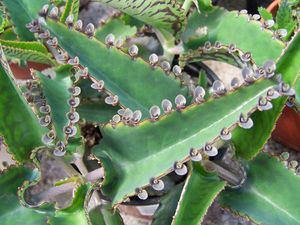 The room temperature can be almost any. However, its limits should fluctuate in the winter in the region of 14C-20C, and in the summer it should not increase above 28C-30C. Temperature within 14C-18C promotes bud formation. Keeping the plant at a lower temperature can lead to root rot and plant death.
The room temperature can be almost any. However, its limits should fluctuate in the winter in the region of 14C-20C, and in the summer it should not increase above 28C-30C. Temperature within 14C-18C promotes bud formation. Keeping the plant at a lower temperature can lead to root rot and plant death.- When caring for the Kalanchoe, you can not monitor the humidity in the room. Moisture evaporates slowly from its fleshy leaves, so they don't need to be sprayed and they thrive even in hot weather.
- At home, succulents are watered with settled water as the topsoil dries. Do not let the earthen coma dry out completely, otherwise the leaves of the plant may fall off. In winter, when the plant is kept in a cool room, it is watered 3-4 days after the soil has dried.
- It is recommended to fertilize Kalanchoe only during the period of active growth in summer and during the budding period in the fall. The plant is fed with organic fertilizers twice a period, and mineral fertilizers - four times a month. You can only use special fertilizers for succulents or cacti.
- If the bush of the plant grows strongly, then it will need to be transplanted. The soil for the Kalanchoe should consist of deciduous and sod land, peat and sand (2: 4: 1: 1). In flower shops, you can buy a special earthen mixture designed for planting succulents.
- Timely pruning is required for the development and high-quality growth of flowering Kalanchoe species during plant care. For this, the weak and old parts are removed with a secateurs or a knife. The peduncle is cut low enough. For reproduction, new shoots are used, which take root in a previously prepared substrate.
Reproduction of Kalanchoe
Both flowering and medicinal plants can be propagate both by cuttings and seeds.
Propagation by cuttings
When propagating by cuttings, a piece of the stem is cut off, which is placed in a prepared pot with soil. The stalk is covered with a glass jar and sprayed from time to time. In the same way, the plant can be propagated with the help of a leaf that comes off the mother plant.
Sowing seeds
Succulents reproduce well by seeds, which are sown in deciduous soil. late winter - early spring:
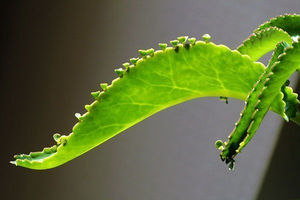 the seeds are not sprinkled with soil from above, but simply pressed;
the seeds are not sprinkled with soil from above, but simply pressed;- the container is covered with glass or cellophane, and placed in a bright place;
- the substrate is sprayed and ventilated daily;
- after the seedlings appear, the glass is removed;
- after about a month, the matured Kalanchoe sprouts are transplanted into separate containers.
Caring for young plants at home consists of regular but infrequent watering, feeding in small doses and the formation of a bush.
The beautiful houseplant Kalanchoe is valued not only for its beautiful flowering, but also for the medicinal properties that the juice of its leaves has. Caring for a succulent plant at home is so simple that even a novice florist can grow a Kalanchoe.

